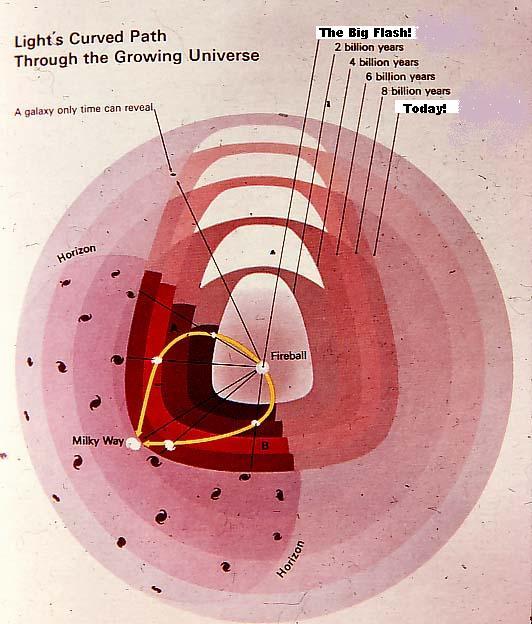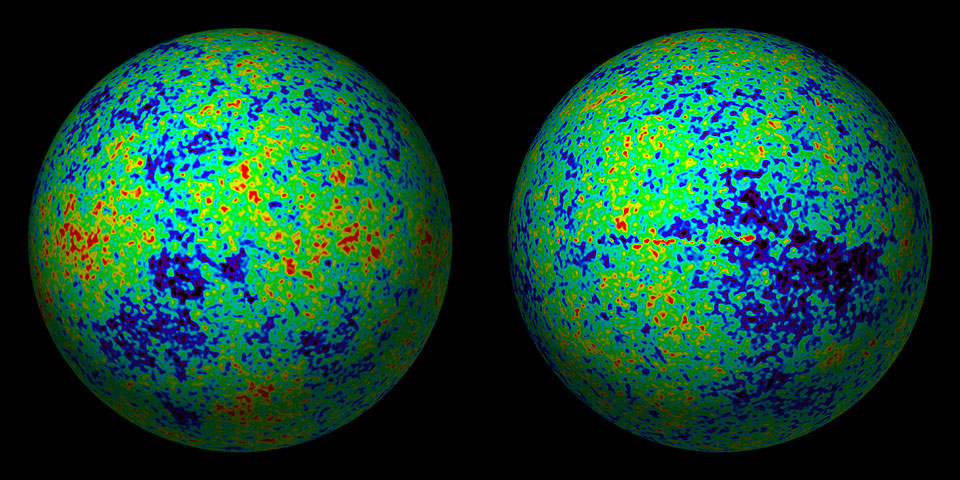
 |
When we look at more and more distant objects, we see further and further into the past. A galaxy 2 billion light years away is seen “now” as it appeared 2 billion years ago. What's the most distant object you can see? How about the entire universe? Suppose we look between the stars, between the galaxies, at the “black” of “empty” space. As the sketch above indicates, no matter in what direction we look, we will eventually be looking at the so-called “Big Flash,” the entire universe at the moment it first became transparent to visible light. The universe did not become transparent until it had cooled to a temperature less than that inside stars today. At a temperature of about 3000 Kelvin, electrons could stay in hydrogen atoms, so that the matter in the universe settled down to gas instead of plasma. [In the vicinity of and inside stars, it is still plasma today.] It's a very, very big difference! Plasmas are opaque to visible light, whereas gases are fairly transparent. At the time of the transition from plasma (bare atomic nuclei and electrons) to gas (hydrogen atoms), the universe was about 380,000 years old. We see the 3000 Kelvin radiation today shifted by the expansion of space over the last 13 billion years down by more than 1/1000, to just 2.7 degrees above absolute zero. We are “moving” that fast relative to the early universe! [And the effect is not due to actual motion, but to the expansion of the space the universe occupies.]

And here it is, as seen by the Wilkinson Microwave Anisotropy Probe satellite! The entire universe is sitting for its baby portrait. Slight temperature differences are greatly exaggerated by the color code (slightly cooler blue, slightly hotter red) assigned within the image. Among many other things, the complex structure revealed in this WMAP image allows the composition and age of the universe to be very accurately determined for the first time. The universe is 13.7 billion years old, a figure that agrees well with the less accurate estimates that are possible using many other, independent measurements. For comparison, the age of the earth itself is “only” about 4.6 billion years, a reliable figure arrived at by study of a number of very different, physically independent time-marking processes. The sun, planets and lesser bodies of the solar system should have formed pretty much all at once, and indeed the measured ages of the earth, sun, various meteorites and the oldest portions of the moon's surface are nicely consistent.
It's important to realize that it's all still out there. For example, the formation of galaxies occurred very early in the history of the universe, and has for a long time been one of the prime unsolved puzzles of astronomy. But recently, the era of galaxy formation has become visible, as telescopes and viewing technology advance. Now, it is possible to compare results of computer models of galaxy formation for the first time to direct observation.
Closer to home in space and time, the formation of stars and planets is going on all the time, all around us, and planetary systems can be viewed in almost every stage of evolution. A typical large galaxy has 100 billion suns lit up at any given time, and stellar births and deaths are almost as common as they are among us little humans here on this little watery blue world. Here are some album pages on star and planetary system formation from the good old Astronomy Picture of the Day website: 1 | 2 | 3 | 4 | 5 | 6.